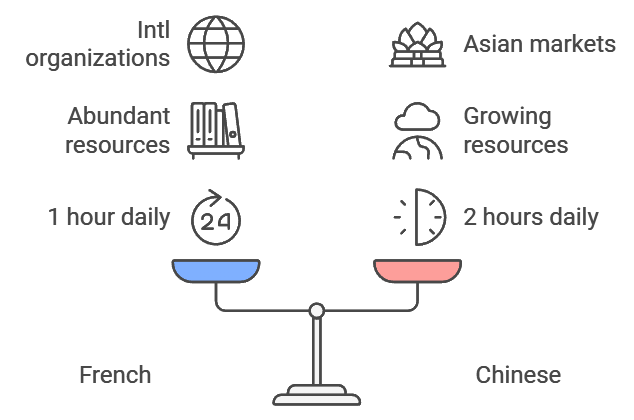Should You Learn French or Chinese? A Data-Driven Guide for 2025
The choice between learning French or Chinese depends on your personal goals, time commitment, and career aspirations. For English speakers seeking quick professional gains in Europe or Africa, French offers a faster path to fluency. However, if you’re focused on long-term business opportunities in Asia and don’t mind a steeper learning curve, Chinese could provide greater economic returns.
Key Takeaways
- French takes 24-30 weeks to reach basic fluency, while Chinese requires 88-98 weeks
- Chinese speakers earn 12% higher salaries in tech sectors compared to French speakers
- French opens doors to 300 million speakers across 29 countries
- Chinese provides access to 1.1 billion speakers and the world’s second-largest economy
- Both languages offer significant digital economy opportunities, with Chinese leading in e-commerce and French in international organizations
Language Learning Complexity
Learning a new language is like building a house – you need the right tools and a solid plan. Let’s break down what you’re facing with each language.
French Learning Curve
French shares about 27% of its vocabulary with English, making it relatively accessible for English speakers. The main challenges include:
- Gendered nouns (le/la)
- Verb conjugations
- Silent letters
- Nasal sounds
Most students reach conversational fluency within 6-8 months of dedicated study. The familiar alphabet means you can start reading almost immediately.
Chinese Learning Curve
Chinese presents unique challenges but offers simpler grammar than French. Here’s what you’ll encounter:
- 4 tones that change word meanings
- 2,000-3,000 characters needed for basic literacy
- No alphabet system
- Simple grammar with no conjugations
| Learning Aspect | French | Chinese |
|---|---|---|
| Time to Basic Fluency | 24-30 weeks | 88-98 weeks |
| Writing System | Latin alphabet | Characters |
| Grammar Complexity | High | Low |
| Pronunciation | Moderate | Challenging |
| Vocabulary Similarity to English | High | Very Low |
Economic and Career Impact
The financial returns of language learning vary significantly by industry and region. Recent data shows interesting trends:
French Market Value:
- 20% salary increase in international organizations
- Strong demand in African startups (32% growth in 2023)
- Required in 8% of European Union positions
- Leading language in luxury goods industry
Chinese Market Value:
- 25% higher salaries in tech sectors
- Required in 15% of Asian market positions
- Dominant in manufacturing sectors
- Essential for Belt and Road Initiative projects
Digital Age Relevance
The digital economy has transformed language learning value. Here’s what’s happening online:
Online Presence Statistics
- Chinese social media users: 1.1 billion
- French social media users: 280 million
- E-commerce market size (Chinese): $2.1 trillion
- E-commerce market size (French): $185 billion
Tech Industry Impact
Both languages play crucial roles in technology, but in different ways:
Chinese Technology Sector:
- AI development hubs
- Mobile payment innovation
- E-commerce leadership
- Gaming market dominance
French Technology Sector:
- Cybersecurity initiatives
- Startup ecosystems
- AI ethics frameworks
- Digital transformation consulting
Making Your Decision
Consider these practical factors when choosing:
- Time Availability
- French: 1 hour daily for 6 months
- Chinese: 2 hours daily for 18 months
- Learning Resources
- French: Abundant free resources
- Chinese: Growing online platforms
- Career Goals
- International organizations: French
- Asian markets: Chinese
- Tech industry: Either (market-dependent)

Future Outlook
Language trends suggest interesting developments:
French Growth Areas:
- African tech hubs
- Sustainable development projects
- Cultural industries
- International diplomacy
Chinese Growth Areas:
- Digital commerce
- Artificial intelligence
- Green technology
- Space technology
Investment and Returns
Understanding the financial aspect helps make an informed decision:
| Aspect | French | Chinese |
|---|---|---|
| Course Costs | $500-2,000 | $1,000-3,500 |
| Study Materials | $200-500 | $300-800 |
| Certification | $250-400 | $300-600 |
| Salary Premium | 10-15% | 15-25% |
The choice between French and Chinese ultimately depends on your personal and professional goals. Consider your time availability, learning style, and career aspirations. Remember that any language learning journey requires dedication and consistency, but the rewards – both cultural and professional – can be significant.
Think about where you see yourself in five years. Which language aligns better with that vision? The answer to that question might be your best guide in making this important decision.
